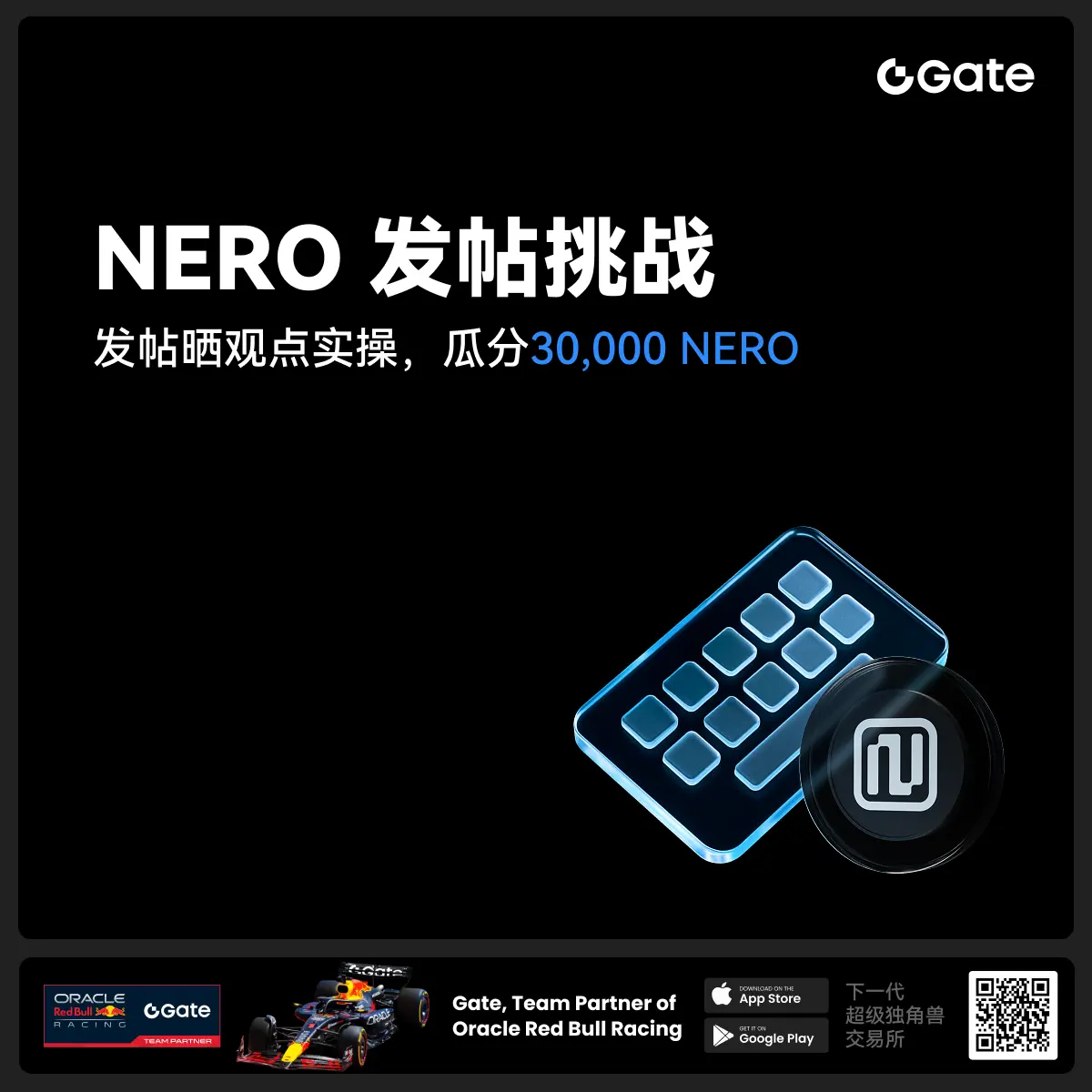- 話題1/3
11741 熱度
165333 熱度
19164 熱度
31989 熱度
96118 熱度
- 置頂
- 👀 家人們,最近你們都攢了多少 Alpha 積分啦?
空投領到了沒?沒搶到也別急,廣場給你整點額外福利!
🎁 曬出你的 Alpha 收益,咱們就送你$200U代幣盲盒獎勵!
🥇 積分最高曬圖用戶 1 名 → $100 代幣盲盒
✨ 積分榜前五優質分享者 5 名 → 各得 $20 代幣盲盒
📍【怎麼玩】
1️⃣ 帶上話題 #晒出我的Alpha积分收益# 發廣場貼
2️⃣ 曬 Alpha 積分截圖 + 一句話總結:“我靠 Gate Alpha 賺了 ____,真的香!”
👉 還可以分享你的攢分技巧、兌換經驗、積分玩法,越乾貨越容易中獎!
📆【活動時間】
8月4日 18:00 - 8月10日 24:00 (UTC+8)
- 🎉 #CandyDrop合约挑战# 正式開啓!參與即可瓜分 6 BTC 豪華獎池!
📢 在 Gate 廣場帶話題發布你的合約體驗
🎁 優質貼文用戶瓜分$500 合約體驗金券,20位名額等你上榜!
📅 活動時間:2025 年 8 月 1 日 15:00 - 8 月 15 日 19:00 (UTC+8)
👉 活動連結:https://www.gate.com/candy-drop/detail/BTC-98
敢合約,敢盈利
- 🎉 攢成長值,抽華爲Mate三折疊!廣場第 1️⃣ 2️⃣ 期夏季成長值抽獎大狂歡開啓!
總獎池超 $10,000+,華爲Mate三折疊手機、F1紅牛賽車模型、Gate限量週邊、熱門代幣等你來抽!
立即抽獎 👉 https://www.gate.com/activities/pointprize?now_period=12
如何快速賺成長值?
1️⃣ 進入【廣場】,點擊頭像旁標識進入【社區中心】
2️⃣ 完成發帖、評論、點讚、發言等日常任務,成長值拿不停
100%有獎,抽到賺到,大獎等你抱走,趕緊試試手氣!
截止於 8月9日 24:00 (UTC+8)
詳情: https://www.gate.com/announcements/article/46384
#成长值抽奖12期开启#
- 📢 Gate廣場 #NERO发帖挑战# 秀觀點贏大獎活動火熱開啓!
Gate NERO生態周來襲!發帖秀出NERO項目洞察和活動實用攻略,瓜分30,000NERO!
💰️ 15位優質發帖用戶 * 2,000枚NERO每人
如何參與:
1️⃣ 調研NERO項目
對NERO的基本面、社區治理、發展目標、代幣經濟模型等方面進行研究,分享你對項目的深度研究。
2️⃣ 參與並分享真實體驗
參與NERO生態周相關活動,並曬出你的參與截圖、收益圖或實用教程。可以是收益展示、簡明易懂的新手攻略、小竅門,也可以是行情點位分析,內容詳實優先。
3️⃣ 鼓勵帶新互動
如果你的帖子吸引到他人參與活動,或者有好友評論“已參與/已交易”,將大幅提升你的獲獎概率!
NERO熱門活動(帖文需附以下活動連結):
NERO Chain (NERO) 生態周:Gate 已上線 NERO 現貨交易,爲回饋平台用戶,HODLer Airdrop、Launchpool、CandyDrop、餘幣寶已上線 NERO,邀您體驗。參與攻略見公告:https://www.gate.com/announcements/article/46284
高質量帖子Tips:
教程越詳細、圖片越直觀、互動量越高,獲獎幾率越大!
市場見解獨到、真實參與經歷、有帶新互動者,評選將優先考慮。
帖子需原創,字數不少於250字,且需獲得至少3條有效互動
- 🎉 親愛的廣場小夥伴們,福利不停,精彩不斷!目前廣場上這些熱門發帖贏獎活動火熱進行中,發帖越多,獎勵越多,快來GET你的專屬好禮吧!🚀
1️⃣ #GateLaunchpad上线IKA# |IKA認購體驗
在Gate廣場帶話題曬出你的IKA Launchpad認購體驗,4位幸運分享者講瓜分$200分享獎池!
詳情 👉️ https://www.gate.com/post/status/12566958
2️⃣ #ETH冲击4800# |行情分析預測
大膽發帖預測ETH走勢,展示你的市場洞察力!10位幸運用戶將平分0.1 ETH 獎勵!
詳情 👉️ https://www.gate.com/post/status/12322403
3️⃣ #创作者活动第二期# |ZKWASM話題
在廣場或推特發布與 ZKWASM 或其交易活動相關的原創內容,瓜分4,000枚ZKWASM!
詳情 👉️ https://www.gate.com/post/status/12525794
4️⃣ #Gate广场征文活动第二期# |ERA話題
談談你對ERA的觀點/體驗,參與並推廣活動,700 ERA大獎等你贏!
詳情 👉️ https://www.gate.com/post/status/12361653
5️⃣ #MBG任务挑战# |MBG話題
分享你對MBG的洞察,積極參與和推廣MBG活動,20位小
解析當下三大熱門以太坊標準:EIP-6969、ERC-721C 和ERC-6551
撰文:David
在過去的一周中,我們從各個渠道至少看到了3 個密集被討論的以太坊相關標準。這些標準分別是EIP-6969、ERC-721C 和ERC-6551,它們各自具有不同的用途和潛在影響。
每一個標準都有可能形成或改變一種業態,因此其重要性不言而喻。提前了解也有助於發現目前的新動向和趨勢。
然而,加密世界的一個特點是信息過於零散和突發,加之精力有限,你很可能無法深入了解每一個標準的技術特徵以及可能帶來的影響。因此,深潮旨在將這些標准進行匯總、解讀和比較,帶領您以通俗易懂的方式全面了解它們。
1.EIP6969:利好智能合約創建者和L2 生態?
EIP-6969 是一項提案,最早在5 月8 號左右出現,它提出了一個通用的協議,旨在實現合約保護收入(CSR),該提案可以看作是之前EIP-1559 的改進版。
說人話就是:該協議希望允許智能合約的創建者,能從用戶使用合約產生的Gas 費中分一杯羹。
提案的共同作者@owocki 也提到,希望通過這種機制對智能合約開發者進行激勵,以推動以太坊L2 生態系統的發展,而以太坊的L1 上則不希望實施這種提案,以保持L1 的中立性。
筆者的解讀是,這種激勵機制如果能在以太坊L1 實施,勢必會出現很多良莠不齊想刷量的智能合約,進而造成擁堵,整體看弊大於利,因此放到L2 上可能是更好選擇。
但是,要完全讀懂這個EIP-6969 提案,需要搞清楚以太坊目前gas 費的運作原理和構成。這就涉及到了之前的EIP-1559。
EIP-1559 與21 年8 月以太坊的倫敦硬分叉時生效,規定了用戶支付的交易費用有不同的去向:
很明顯,EIP-1559 其實並沒有怎麼考慮合約開發者的利益。實際上以太坊作為公鏈,你可以把供給方看成兩部分:
總結來看,EIP-6969 與EIP-1559 存在聯繫和區別。 EIP-1559 是一個關注交易費用機制的協議改進提案,旨在提供更穩定和可預測的交易費用,並管理網絡擁塞。與此類似,EIP-6969 在維持EIP-1559 優點的基礎上,通過引入合約創建者收益機制,進一步對齊了合約創建者和網絡的激勵機制,促進了合約創建者的參與和獎勵。
我們可以用下表來清晰的展示EIP-6969 的功能和影響,以及它與EIP-1559 的淵源:
注意,我們認為這個新協議的主要風險在於,如果激勵合約的開發者能收到gas 費,那麼是否會引出更多垃圾合約的出現?因此這裡面實際上是有合約的安全性風險,以及佔用整個公鏈上的公共資源的風險在裡面的。
2. ERC-721C:NFT 版稅的鏈上化
ERC-721C 是由Limit Break 提出的,它是對以太坊上ERC-721 非同質化代幣(NFT)標準的改進。它的主要目標是給予NFT 創作者更多對其NFT 集合以及版稅處理方式的控制權和自定義能力。
*深潮注:Limit Break 是一家免費遊戲開發工作室,於2021 年1 月引入了創作者代幣(Creator Token) 的概念。 ERC721-C 標準1.1 版於2023 年5 月上線,該標準實施了許多創作者代幣的概念。 @huntersolaire_也在推文中闡述了該標準的細節。 *
Limit Break 的官方「Creator Token Transfer」庫顯示,ERC721-C 目前可在以太坊和Polygon 上運行。以太坊的Sepolia 測試網和Polygon 的孟買測試網也支持它。
從創作者代幣這個名字上來說,ERC721-C 顯然更多的是為創作者考慮,因此這個協議更多的在考慮版稅的保護。
說人話版本:在當前的ERC-721 標準下,版稅其實只是一個商業約定,而非鏈上可強制執行。 ERC-721C 的提出旨在解決這一問題,使版稅成為可以在區塊鏈上強制執行的智能合約規則。
有了ERC721-C,一些可能的用途包括:
ERC-721C 的推出將對NFT 行業產生重要影響:
一張表總結ERC-721C:
3.ERC-6551: 當NFT 也是一個賬戶
ERC-6551 通過賦予NFT 智能合約錢包的能力,增強了NFT 的功能和價值。
該協議的聯合作者是@BennyGiang,他是Dapper Labs 的創始成員之一,團隊曾致力於ERC-721 代幣標準和早期項目,如CryptoKitties。
常規ERC-721 NFT 的問題在於其受限範圍。它們只能被擁有和轉讓,無法擁有其他資產,如代幣或其他NFT。此外,它們無法與其他智能合約進行互動,也無法根據外部因素或用戶輸入的變化或演進。
ERC-6551 通過為NFTs 引入智能合約錢包的概念,解決了常規ERC-721 NFTs 功能的限制。它通過註冊表和代理合約的組合,使得NFT 本身也能夠持有其他資產、與其他智能合約和賬戶進行交互,實現更豐富的功能和互動性。
因此,你可以具體理解成,遵循ERC-6551 的代幣(NFT)將會作為智能合約錢包進行運作。這意味著ERC-6551 可以像普通智能合約錢包一樣持有代幣和其他NFT,並進行交易,且能夠與其他智能合約和賬戶例如去中心化交易所(DEX)、借貸平台、遊戲環境等進行交互。
這種將NFT 作為智能合約錢包進行運作的方式,形成了所謂的「綁定代幣賬戶」(Token-Bound Accounts,TBAs),它通過與現有的ERC-721 NFT 兼容的無權限註冊表創建和管理。
簡單總結一下, ERC-6551 可能帶來的好處和問題有:
EIP 和ERC,傻傻分不清?
寫到這裡,不免還是會想起一個老生常談的問題,EIP 和ERC 到底有啥區別?
EIP(Ethereum Improvement Proposal)和ERC(Ethereum Request for Comments)都是與以太坊(Ethereum)相關的提案標準,但它們確有區別。
EIP 是以太坊網絡的改進提案標準,用於描述對以太坊協議的改進和新功能的提案。一旦EIP 被採納和同意,它將成為以太坊協議的一部分,並被實施在以太坊網絡上。 EIP 描述了協議層面的變更,例如改進區塊鏈機制、虛擬機規則、共識算法等;
相反,ERC 是以太坊的代幣標準,用於描述代幣合約的接口和功能。 ERC 定義了代幣合約的基本標準,以確保代幣在以太坊網絡上的互操作性。 ERC 是針對代幣合約的規範,描述了代幣的轉移、餘額查詢、元數據等功能。
所以,儘管EIP 和ERC 都是以太坊社區的標準化機制,但它們關注的領域不同。 EIP 關注協議層面的改進,而ERC 關注代幣合約的規範化。因此,EIP 不會直接轉變為ERC,它們是獨立的概念。